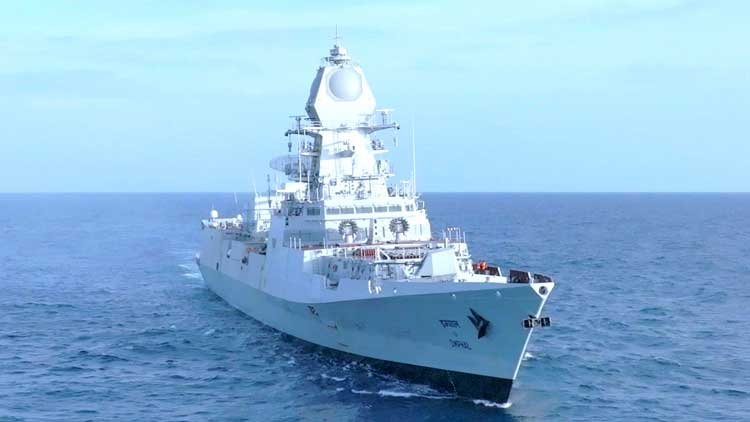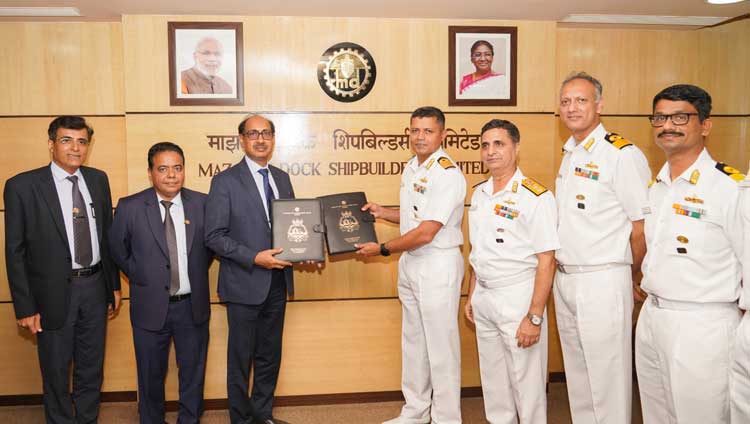INDIAN ARMED FORCES CHIEFS ON OUR RELENTLESS AND FOCUSED PUBLISHING EFFORTS

The insightful articles, inspiring narrations and analytical perspectives presented by the Editorial Team, establish an alluring connect with the reader. My compliments and best wishes to SP Guide Publications.

"Over the past 60 years, the growth of SP Guide Publications has mirrored the rising stature of Indian Navy. Its well-researched and informative magazines on Defence and Aerospace sector have served to shape an educated opinion of our military personnel, policy makers and the public alike. I wish SP's Publication team continued success, fair winds and following seas in all future endeavour!"

Since, its inception in 1964, SP Guide Publications has consistently demonstrated commitment to high-quality journalism in the aerospace and defence sectors, earning a well-deserved reputation as Asia's largest media house in this domain. I wish SP Guide Publications continued success in its pursuit of excellence.
- Operation Sindoor: Resolute yet Restrained
- India’s Operation Sindoor Sends a Clear Message to Terror and the World – ‘ZERO TOLERANCE’
- Japan and India set forth a defence cooperation consultancy framework, talks on tank and jet engines
- Terrorist Attack in Pahalgam in Kashmir: Unfolding a long surgical war against PAK
- Lt General Pratik Sharma takes over Command of Indian Army's Northern Command
Indigenous Destroyer 'Imphal' Delivered
India's indigenous defence manufacturing capabilities reach new heights with the delivery of INS Imphal, the third P15B stealth-guided missile destroyer
 |
The Author is Former Director General of Information Systems and A Special Forces Veteran, Indian Army |

On October 20, 2023, Yard 12706 (Imphal), the third Project 15B (P15B) stealth-guided missile destroyer, crafted at Mazagon Dock Shipbuilders (MDL) in Mumbai, was officially handed over to the Indian Navy (IN). This delivery signaled a leap forward in India's quest for self-reliance in defence manufacturing and bolstering India's maritime capabilities in the Indian Ocean Region (IOR). The Imphal destroyer is the latest addition to the arsenal of the Indian Navy, following her predecessors, the Indian Naval ships 'Visakhapatnam' and 'Mormugao', commissioned in the past two years.
INS Imphal's induction into the Indian Navy marks a significant milestone in India's quest for self-reliance in defence manufacturing and bolstering its maritime capabilities in the Indian Ocean Region (IOR)
With an overall length of 164 metres and with a displacement of 7,400 tonnes, the Imphal destroyer is a versatile platform equipped with weaponry and sensors including surface-to-air missiles (SAMs), anti-ship missiles (ASMs) and torpedoes. It is powered by a Combined Gas and Gas (COGAG) propulsion set consisting of four gas turbines. The vessel can achieve speeds of more than 30 knots or 45 km/h. About 74 per cent content of the Imphal destroyer is indigenous with components made in India (as compared to 59 per cent in the Kolkata-class destroyers and 42 per cent in the Delhi-class destroyers). These include medium-range surface-to-air missiles from Bharat Electronics Limited (BEL) in Bengaluru, BrahMos surface-to-surface missiles (SSMs) by BrahMos Aerospace in New Delhi, indigenous torpedo tube launchers crafted by Larsen & Toubro (L&T) in Mumbai, anti-submarine indigenous rocket launchers also from L&T, and a 76mm super rapid gun mount manufactured by Bharat Heavy Electrical Limited (BHEL) in Haridwar.


INS Imphal's keel was laid on May 19, 2017, and it was launched into the water on April 20, 2019. The ship embarked on its maiden sea trials on April 28, 2023, followed by a series of trials in the harbour and at sea. The entire process culminated in the vessel's delivery within six months. Induction of the Imphal destroyer has had collaborative efforts from numerous indigenous stakeholders, representing a leap towards enhancing India's maritime strength and influence in the strategically vital IOR. Imphal's technology, indigenous components and construction exemplify India's commitment to self-sufficiency in defence manufacturing. This vessel is set to play an important role in safeguarding India's maritime interests.
In March 2009, the Defence Acquisition Council (DAC) had approved the procurement of four 6,800 tonne destroyers, to be built by the MDL. Designed as a "follow-on" project to the Kolkata-class destroyers, the new destroyers were envisaged to feature only incremental changes to the former, in order to minimise developmental time and costs; cheaper than other destroyer classes being built at the time. No competitive bidding was conducted for the development of the vessels, since MDL was the only Indian shipyard at the time with the capability to build destroyers. The contract for the construction of the four warships was signed on January 28, 2011, at an estimated cost of 29,643.74 crore.
With 74 per cent indigenous content, INS Imphal exemplifies India's commitment to self-sufficiency in defence manufacturing
These were to become the Visakhapatnam-class destroyers, also classified as the P15 Bravo class, or simply called P15B. The P15B destroyers were designed by the Warship Design Bureau (WDB), formerly the Directorate of Naval Design, a branch of the IN responsible for designing the warships, several among them including the Arihant-class submarines - India's first indigenously designed nuclear-powered ballistic missile submarines, INS 'Vikrant' - India's first indigenously designed aircraft carrier and the Kolkata-class destroyers. The goal of the project was to develop a line of destroyers that were comparable to the Kolkata-class destroyers, with only several incremental alterations in order to minimise its development time and associated costs. The design plans of the four vessels were completed by the WDB in mid-2013.
In accordance with naval traditions, the four P15B destroyers were named after major Indian cities with historical and cultural connections, namely, Visakhapatnam, Mormugao, Imphal and Surat representing the Indian states of Andhra Pradesh, Goa, Manipur and Gujarat.

The keel of the first vessel, INS Visakhapatnam, was laid by MDL in October 2013 and the ship was launched on April 20, 2015. The delivery of the vessel was delayed owing to delays in the supply of the vessel's sensors and ordnance and subsequently the COVID-19 pandemic. On November 21, 2021, INS Visakhapatnam was commissioned into the IN. Mormugao was delivered to the IN on November 24, 2022 and was commissioned on December 18, 2022. As mentioned above, INS Imphal was delivered to the IN on October 20, 2023 and is scheduled to be commissioned in late 2023. Construction of the fourth P15B destroyer Surat began in July 2018 and its hull was launched on May 17, 2022. Surat is scheduled to be commissioned in 2024.
The P15B destroyers are equipped with state-of-the-art technology, including a Total Atmosphere Control System (TAC) that allows them to operate in regions of nuclear fallout
The P15B destroyers are equipped with a Total Atmosphere Control System (TAC), which allows them to operate in regions of nuclear fallout. Additionally, the destroyers are also equipped with nuclear, biological and chemical; (NBC) protective equipment, with its entire requirement of air being filtered through NBC filters. These destroyers feature multiple fire zones, battle damage control systems and distributional power systems for improved survivability and reliability in emergent conditions. These warships feature ergonomically designed accommodations based on modular concepts, which ensures a significant amount of crew comfort.
In October 2023, India celebrated another step towards self-sufficiency in defence manufacturing with the handover of the Tejas twin-seater fighter aircraft to the Indian Air Force (IAF). According to GlobalData's The Global Naval Vessels and Surface Combatants Market 2023–2033 report, China is the largest market in the Asia-Pacific region with a 28.9 per cent share, followed by India having a 20.0 per cent share.





